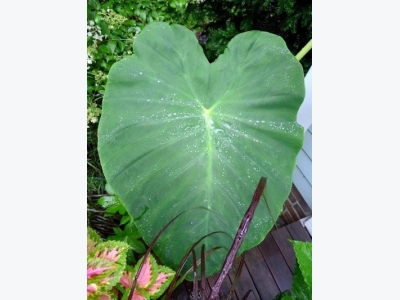Tips For Growing Elephant Ear Plants

The elephant ear plant (Colocasia) provides a bold tropical effect in nearly any landscape setting. In fact, these plants are commonly grown for their large, tropical-looking foliage, which is reminiscent of elephant ears. Keep reading to learn more about how to take care of an elephant ear plant. Elephant Ears Gardening Uses There are a number of uses for elephant ears in the garden. These plants come in a variety of colors and sizes. Elephant ear plants can be used as background plants, ground covers, or edging, especially around ponds or along walkways or patio enclosures. Their most common use, however, is as an accent or focal point. Many are even well adapted to growing in containers. Planting Elephant Ear Bulbs
Growing elephant ear plants is easy. Most of these plants prefer rich, moist soil and can be grown in full sun, but they generally prefer partial shade. The tubers can be placed directly outdoors once the threat of frost or freezing temperatures have ceased in your area. Plant the tubers about 2 to 3 inches deep, blunt end down. Planting elephant ear bulbs indoors approximately eight weeks prior to the last frost date is also acceptable. If growing in pots use a rich, organic potting soil and plant them at the same depth. Harden off elephant ear plants for about a week prior to placing them outdoors. How to Take Care of an Elephant Ear
Plant Once established, elephant ears require little attention. During dry spells, you may want to water plants regularly, especially those growing in containers. Although not absolutely necessary, you may also want to apply a slow-release fertilizer to the soil periodically. Elephant ears cannot survive winter outdoors. Freezing temperatures kill foliage and damage tubers. Therefore, in areas with harsh, cold winters (like those in northernmost regions), the plants must be dug up and stored indoors. Cut the foliage back to about a couple of inches after the first frost in your area and then carefully dig up the plants. Allow the tubers to dry out for about a day or two and then store them in peat moss or shavings. Place them in a cool, dark area such as a basement or crawlspace. Container plants can either be moved indoors or overwintered in a basement or protected porch.
Related news
 15 Gardening Tips for Growing Melons
15 Gardening Tips for Growing Melons Melons are some of the most popular fruits grown on the vine in the U.S. Many backyard gardens feature melons as a favorite late summer and early fall
 How to Grow Great Green Geans In Containers
How to Grow Great Green Geans In Containers Beans adapt well to containers, so you can enjoy their crisp snap and tender taste even if you don’t have a plot of land.
 How to Make Sturdy Recycled Newspaper Pots
How to Make Sturdy Recycled Newspaper Pots Making seed pots out of old newspapers is not only a thrifty use of the newspapers, but also good for the planet.